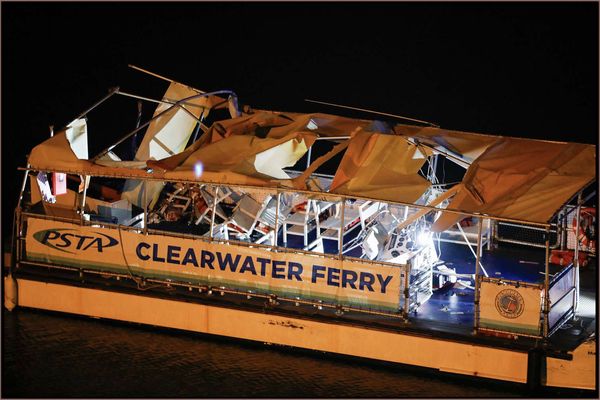Complaints and intrigue fill the air in Walcha, a once tight-knit town atop the Great Dividing Range because power and money are pitting neighbour against neighbour as this old farming community grapples with a new, rapidly growing industry.
If a Danish-backed development gets the green light, 119 wind turbines — soaring 230 metres high — could soon be dotted across this vast, rich farmland, generating enough clean energy to power 375, 000 homes a year.
Dozens of farmers are set to cash in.
The Fletcher family — who have been in Walcha since 1863 — are among the few willing to speak publicly in favour of the project.
They're slated to host nine turbines across their three properties, seeing it as a golden opportunity to future-proof their farm while also helping to cut emissions.
While the details of their contract are confidential, developers are offering landholders between $15,000 and $30,000 per turbine per year for the life of the contract, generating an enviable passive income in good years and bad.
"I think this is the greatest gift [to be] received since the establishment of the agricultural industry in Australia," Holly Fletcher said.
"I know a lot of people would question that, but we haven't seen an opportunity like this in the bush.
"I don't think we'll see another opportunity like this again in our lifetime."
The town, too, is set to cash in with the developer promising to contribute $1 million into a Community Benefit Fund, plus $750,000 a year over the life of the project.
While it has been 20 years in the making, the Winterbourne Wind Project was conceived by local landholders before being sold to the Danish-owned wind turbine company Vestas in 2019 and on-sold to investment firm Copenhagen Infrastructure Group.
However, according to some locals, it was only late last year when the Environmental Impact Statement was released that the community first learned the size and scope of the project, and its proximity to the town.
Stock and station agent Bruce Rutherford has lived in Walcha for nearly 40 years and said Winterbourne had "divided the community", between those wanting to seize the opportunities and those worried about the costs.
"People have stopped talking to one another, more than anything," he said.
"I know neighbours who don't talk to neighbours just purely because one's hosting wind towers and the next neighbour doesn't want them and is not interested in having them.
"There's no one brawling in the streets, but they're just not talking. They've lost contact."
Opponents feel they've been left out of the process and complain of "needless secrecy", while those backing the project claim they have been isolated and their businesses boycotted.
The Walcha Council has taken a "neutral" stance on the development as it progresses through the New South Wales government approvals process. However, its mayor, Eric Noakes, feels frustrated about the position the town of 3,000 finds itself in.
When asked what's gone wrong, he said: "Poor community engagement over a long period of time."
"The project was seen as being well out of Walcha, over a hill where people wouldn't see it," Cr Noakes said.
"All of a sudden, the towers got a lot bigger and got a lot closer to Walcha."
The New England region — which takes in Walcha — has been declared a Renewable Energy Zone by the state government, earmarked to produce 8 gigawatts of clean energy, roughly the equivalent of three coal-fired power stations.
The aim is to help meet ambitious state and federal government climate targets, which are super-charging the race towards renewables in the regions.
To meet the national target of cutting emissions by 43 per cent by 2030, federal Energy Minister Chris Bowen estimates Australia needs to install 40 wind turbines every month, and 22 thousand solar panels every day, backed by at least 10,000 kilometres of additional transmission lines.
As a result of these policies, Australia's Energy Infrastructure Commissioner Andrew Dyer warns regions across the country could experience "increased clustering" of projects, which "may result in multiple projects infiltrating and 'surrounding' communities".
That is the feeling in Walcha, where farmers such as Mr Rutherford fear their bucolic landscape will be scarred.
"If the Winterbourne project got up and there's 119 towers out there, I don't think that'd be the end of the world," Mr Rutherford said.
"But, for Walcha, as small community, they're talking about a total of 600-700 towers in a number of different projects.
"If that happened, it'd be a disaster, it's going to turn this place into an industrial wasteland while they build them."
Biggest wind farm in the country
North of the border, in Queensland, construction is underway on one of the biggest wind farms in the world.
The almost $2 billion McIntyre Wind Farm — backed by the Queensland government and Spanish renewable energy giant Acciona — will see 180 turbines built across a large slice of grazing country.
Business at the local Karara Tavern is booming, thanks to the hundreds of workers housed at a nearby construction camp.
"We've gone from doing, say, 10 a night to sometimes we do 60 meals a night now," owner Kerry Wilson said.
However, that has also come at a cost. The roads, she said, are now a "mess", and full of potholes.
Down the road from the Tavern, wool grower Brent Finlay is set host more than a dozen turbines on his property and said there was "a level of excitement" about the project in the community.
"This is a region that has been heavily impacted by a number of severe droughts over the last 20 years," he said.
"There's very little chance to diversify, so part of having another industry come into our region, onto our land, was a chance to diversify, to spread the risk."
Mr Finlay acknowledges projects such as these are disruptive and described the initial stages as "bumpy".
As a former president of the National Farmers' Federation, Mr Finlay sees some similarities between this rapid expansion of renewables and the emergence of the coal-seam gas industry decades ago.
And while he supports the economic opportunities a project such as the McIntyre Wind Farm offers, he said there was a sense that regulators were playing catch up.
"It can't be open slather," he said. "There are some very big, long-term, known companies that are operating, but there's also now a lot of what I call 'junior explorers' that are popping up."
"There is still a feel of lack of government planning."
As Australia’s first Energy Infrastructure Commissioner, it is Mr Dyer’s job to deal with community complaints about wind and solar projects, and to develop better policies as the industry rapidly expands.
Mr Dyer suggested developers of onshore windfarms should be subject to the same arrangements as those developing offshore windfarms, which must be licensed and face far more restrictions.
"There is a wide spectrum of developers active in the industry," he said in his annual report.
"Currently, developers are not licensed to prospect wind or solar farm projects, nor do they require approval to prospect in a location for a potential project site."
Genuine engagement is key
As construction of renewable projects picks up pace — and regulators play catch up — farmers such as Queensland wool grower Mr Finlay say genuine engagement with host communities is key.
"Open lines of communication, they're so important," he said.
If Winterbourne is approved, construction could begin next year, bringing 400 temporary workers to town.
Locals — already wary of the project — are anxious about their roads being destroyed by a convoy of trucks carting the massive turbines in to Walcha and the impact the influx of workers could have on rental prices.
However, as Ms Fletcher reflects on the legacy she wants to leave her son, she firmly believes the long-term benefits will outweigh these shorter-term disruptions.
“It's not about us. It's about the future generations,” she said.
“It’d be nice to know that we've made decisions now that'll afford a better life for them later on.”







